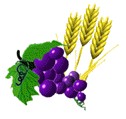






Why is there such confusion in food PH values? It's because there are 2 different ways
to measure it. One way is to measure a food's PH value before we eat it. The second
way is to measure a food's PH value after we eat it. There are websites that
contain each of these values. And these values are NOT the same- they are totally different.
That's where part of the confusion comes into play. In this web page I deal with a food's
PH value after we eat it. The food industry term for this is PH FORMING foods.
For instance, the PH value for an orange before we eat it is acidic, however, after we
eat it- it turns alkaline in our body.
PH in chemistry stands for "potential of hydrogen." What is that? It's the
measure of the acidity or alkalinity of a solution. It is measured on a scale of
0 to 14 with 14 being the most alkaline, while 0 is the most acidic.
Water is neutral and our blood is mostly water. God created our
blood to have a PH of 7.0 which is neutral. The goal for each person should be to eat
the right kinds of foods to maintain a healthy pH of 7.4 or higher of their blood.
For years I followed the "old wives' tale" to keep your blood PH on the
acidic PH side because a flu virus will invade your blood and a virus cannot live in
an acidic blood stream. It's true I didn't catch the flu very often but my acidic blood
added to me having a lot of other undesirable health problems including hemorrhoids,
constipation, wrinkled skin, chronic bowel problems, increased body fat, and
increased weight- just to name a few. Also I should mention here that flu germs cannot
live in an alkaline blood stream either. And an alkaline blood PH is much healthier than
an acidic one. Stay on the alkaline side as you don't want to be building up plaque in
your arteries or getting hardening of the arteries before your time. And you don't want
to increase your risk of getting cancer, diabetes, acidosis, kidney problems, or
gout- to name just a few.
Follow the 80/20 rule the best you can. What is that? It's a simple formula to help
you remember to eat 80% alkaline forming foods and only 20% acid forming foods
every day. That means that only 1/5 of all of the food you eat per day should be
acid forming and that 4/5 of all of the food you eat per day should be alkaline forming.
It basically means a major lifestyle change in the way most folks eat. That means that
your thinking has to change first as to what foods you purchase, and that also means
that a lifetime of eating habits has to change. It was hard for me to give up eating meat
when I decided to go on an alkaline diet and you are not expected to change overnight.
Some things take time to adjust to, but when your doctor advises you to change then it
is best to follow his or her instructions. In other words, I would have never traded
eating meat for eating "rabbit food" under any other circumstances.
The following foods listed in the below tables are only for a general food guide
to help you determine which ones are alkaline and acid forming in your body. There are
other foods that are not listed here but I feel these are the most basic ones.
9.0 Lemons, Watermelon
Artichoke (globe), Maple Syrup, Yogurt, and White Pumpkin Seeds, Butter (fresh, unsalted),
Cream of Wheat (unrefined), Fish, Wine, Yogurt (sweetened)
Artificial sweeteners
Agar Agar, Cantaloupe, Cayenne (Capsicum), Dried dates & figs, Kelp, Karengo,
Kudzu root, Limes, Mango, Melons, Papaya, Parsley, Seedless grapes (sweet),
Watercress, Seaweed, Asparagus, Endive, Kiwifruit, Fruit juices, Grapes (sweet),
Passion fruit, Pears (sweet), Pineapple, Raisins, Umeboshi plum,
Vegetable juices
Apples (sweet), Apricots, Alfalfa sprouts, Arrowroot, Avocados, Bananas (ripe),
Berries, Carrots, Celery, Currants, Garlic, Gooseberry, Strawberries,
Grapefruit, Guavas, Herbs (leafy green), Lettuce (leafy green),
Nectarines, Peaches (sweet), Peas (fresh sweet), Persimmons, Turnips,
Pumpkin (sweet), Sea salt, Spinach
Apples (sour), Bamboo shoots, Raspberries, Sapote, Sweet corn (fresh),
Beans (fresh green), Beets, Bell Pepper, Broccoli, Cabbage, Tamari, Vinegar (apple cider),
Cauliflower, Carob, Daikon, Ginger (fresh), Kale, Parsnip, Squash, Kohlrabi, Oranges
Almonds, Artichokes (Jerusalem), Brussel Sprouts, Cherries, Coconut (fresh), Cucumbers,
Eggplant, Honey (raw), Leeks, Mushrooms, Okra, Olives (ripe), Onions, Pickles (homemade),
Radishes, Sea Salt, Spices, Tomatoes (sweet), Vinegar (sweet brown rice),
Chestnuts (dry, roasted), Egg Yolks (soft cooked), Essene Bread,
Goat's Milk and Whey (raw), Mayonnaise (homemade), Olive Oil, Sesame Seeds (whole),
Soy Beans (dry), Soy Cheese, Soy Milk, Sprouted Grains, Tofu, Yeast (nutritional flakes)
Some Say Alkaline 7.25 PH, Some Say Acidic 6.75 PH
Barley-Malt (sweetener-Bronner), Brown Rice Syrup, Brussel Sprouts, Yogurt (plain),
Coconut (fresh), Miso, Water Chestnuts Amaranth, Milk, Green Tea, Lima Beans,
Taro, Quinoa, Sauerkraut, Soy Products, Sprouted Seeds, Squashes, Sunflower Seeds,
Goat's milk and whey (raw), Horseradish, Baked Potato with the skin, Nuts,
Millet, Quinoa, Rhubarb, Cream (fresh, raw), Cow's Milk and Whey (raw), Flax Seeds,
Tempeh, Plums, Prunes, Spelt, Molasses (unsulphered organic), Soft boiled eggs,
Barley malt syrup, Barley, Bran, Cashews, Organic Raw Milk (unpasteurized),
Cereals (unrefined with honey-fruit-maple syrup), Cornmeal, Fructose,
Honey (pasteurized), Lentils, Macadamias, Maple syrup (unprocessed),
Margarine, Oils (except olive), Duck eggs, Quail eggs, Herbal Tea, Honey, Kombucha,
Nutmeg, Mustard, Pistachios, Rice or wheat crackers (unrefined),
Rye (grain), Rye bread (organic sprouted), Seeds (pumpkin & sunflower),
Walnuts, Blueberries, Brazil nuts, Butter (salted), Cheeses (mild & crumbly),
Crackers (unrefined rye), Dried beans (mung, adzuki, pinto, kidney, garbanzo),
Dry coconut, Egg whites, Goats milk (homogenized), Olives (pickled), Pecans,
Brazil Nuts, Brussel Sprouts, Buckwheat, Cashews, Corn, Cottage Cheese,
Bananas (green), Buckwheat, Cheeses (sharp), Corn bread,
Egg whole (cooked hard), Wheat bread (sprouted organic), Cranberries,
Ketchup, Mayonnaise, Oats, Pasta (whole grain), Pastry (wholegrain & honey),
Peanuts, Mashed Potatoes (or with no skins), Popcorn (with salt & butter),
Rice (basmati), Rice (brown), Soy sauce (commercial), Tapioca
Fruit juices with sugar, Maple syrup (processed), Molasses (sulphured),
Pickles (commercial), Breads (refined) of corn, oats, rice & rye,
Cereals (refined), corn flakes, Shellfish, Wheat germ, Whole Wheat foods
Beef, Carbonated soft drinks & fizzy drinks, Cigarettes (tailor made),
Flour (white or wheat), Goat, Lamb, White rice, Turkey, Table salt refined & iodized,
Pastries & cakes made from white flour, Pork, Sugar (white), White vinegar (processed),
Beer, Brown sugar, Chicken, Venison, Chocolate, Coffee, Custard with white sugar,
Jams, Jellies, Liquor, Pasta (white), Rabbit, Semolina, Tea black, Wheat bread
![]()
Bread On the Waters shall have neither liability nor responsibility to any person or entity with respect to any loss or damage caused or alleged to be caused directly or indirectly by this information. Nothing reported in this web page or site is intended to diagnose, treat, cure or prevent any disease.

Please do not email me with any specific questions regarding the PH of foods. Rather, please check with your local library for books written on this subject. Thanks:)


 Here is an invitation to you to view my Christian website (Assemblies of God)
Here is an invitation to you to view my Christian website (Assemblies of God)
 How to store food away for an emergency
How to store food away for an emergency


